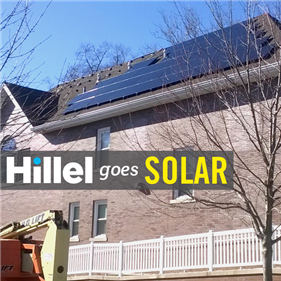Follow the sun

Bradley University just got its first solar powered building.
You guessed it, it’s Hillel.
The Hillel in Peoria, Illinois is the third campus Hillel to derive its energy from solar panels, following University of Florida Hillel and University of Arizona Hillel.
Bradley Hillel installed 47 solar panels on its roof earlier this month, which will provide 90-95 percent of their Hillel’s electricity annually, eventually saving the Hillel an estimated $1,000 per year in energy costs.
“This makes Hillel known on campus,” said Bradley University sophomore Hillel intern Mina Fedderly. “It’s bringing community together and awareness. It’s a positive way to make us known, and hopefully influence other buildings on campus to do the same as what we have done.”
Hillel’s corporate board president, Yona Lunken, agreed. “The students that we service live in the world that we are creating, so we need to show good earth stewardship and doing the solar panel project is such an example.”
The solar panels and installation cost Bradley Hillel nothing—Lunken’s solar panel installation company, Solar Harvest Energy Group, donated time and materials to make it possible.
“We’ve been wanting to go as green as we could,” said Bradley University Executive Director Hillel Seth Katz. “Green is a Jewish value. We had a student president a couple of years ago that got us off of plastic cups. We now have a full meat and dairy kitchen, and a full set of dishes and glassware. We are almost throw-awayless. That was a big part of our waste.”
Bradley Hillel installed its panels on Feb. 2 to coincide with Tu Be’shevat, the Jewish holiday celebrating the new year for trees. Bradley isn’t the first local Hillel to time its installation around this occasion—University of Arizona Hillel put up the cost-saving solar panels in Dec. 2015, around Tu Be’shevat too.
UA Hillel Board of Directors Chair John Judin had prior experience working with solar; he oversaw the installation for solar panels on his synagogue as president in 2011, and a couple of years later, installed solar panels on his own house. He saw the empty roof space at University of Arizona Hillel as an opportunity.
To put the solar panels on its roof, University of Arizona Hillel collaborated with an electric company called Technicians for Sustainability, which leases the roof space from Hillel for $1 a year, and in return, paid for the necessary equipment upfront. University of Arizona Hillel’s solar panels provides 75 percent of the building’s electricity, decreasing the annual electric bill by roughly $400. “To me, the bigger thing was it reduced our carbon footprint tremendously,” said Judin. “We did a minor event around the turning on of the system around Tu B’shevat. The emphasis was on doing what we can to repair the world. The environmental benefit is huge—so huge that it just makes sense.”
Hillel board members, professionals and students alike at UA Hillel are excited about solar energy: Around 40 people attended the University of Arizona Hillel’s Tu B’shevat kickoff event—including Tucson Mayor Jonathan Rothschild.
The first Hillel to go solar was, perhaps not surprisingly, in the Sunshine State. The University of Florida Hillel installed more than 210 panels on it roof in June 2010, funded by federal and state grants, and an anonymous donor.
“Using our solar power is a natural relationship here in Florida,” said CEO of UF Hillel Rabbi Adam Grossman. “We’re trying to have a much lower carbon footprint—that’s our goal.”
Grossman added that using solar energy to power Hillel makes the Hillel building more than just a physical space: “It links [the building] to our Jewish identity and our Jewish values.” Why? “Embedded in our Jewish values is a responsibility to our environment, and more importantly, our world. That includes a relationship with ourselves, each other and our greater world. Having solar panels enables us a way to be more conscious of the imprint we make daily within our world.”